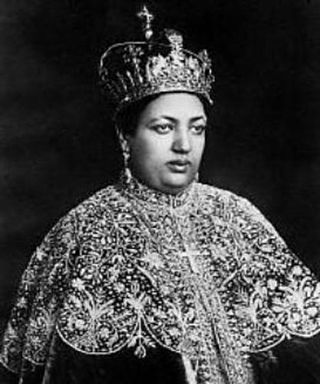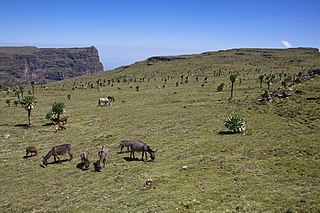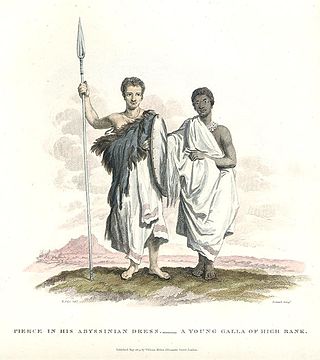| Atse Iyasu | |
|---|---|
| Emperor of Ethiopia | |
| Reign | 1787 – 1788 |
| Predecessor | Iyasu III |
| Successor | Baeda Maryam |
| Dynasty | Ethiopian Empire |
Iyasu or Joshua was a proclaimed emperor of Ethiopia from 1787 to 1788 in Tigray and Gojjam by enemies of Ras Ali I of Yejju. He was defeated in battle against Ras Ali.
He is sometimes given the title Atse, a less familiar Amharic word for "Emperor", to distinguish him from the other emperors of Ethiopia with the same name.
He may be identical with the emperor "Yoas" mentioned by Nathaniel Pearce. Pearce reports that "Yoas" was living in Gondar at the time of his death (May, 1813), and died penniless "without leaving sufficient even to purchase a coffin to receive ... [his] remains, or money enough for fettart or toscar." [1]
Yohannes III was Emperor of Ethiopia intermittently between 1840 and 1851, and a member of Solomonic dynasty. He was the son of Tekle Giyorgis. He was largely a figurehead, with real power in the hands of the Enderase or Regent, Ras Ali II a princeling of the Yejju Dynasty. Ras Ali's mother was the Empress Menen Liben Amede.

Menen Asfaw was Empress of Ethiopia as the wife of Emperor Haile Selassie.

Imba Alaje is a mountain, or an amba, in northern Ethiopia. Located in the Debubawi Zone of the Tigray Region, Imba Alaje dominates the roadway that runs past it from the city of Mek'ele south to Maychew. Because of its strategic location, Emba Alaje has been the site of several battles. As Anthony Mockler describes it,

Tekle Giyorgis I, throne name Feqr Sagad, was Emperor of Ethiopia intermittently between 20 July 1779 and June 1800, and a member of the Solomonic dynasty. He was the youngest son of Yohannes II and Woizoro Sancheviyer, and the brother of Tekle Haymanot II.
Hezqeyas was Emperor of Ethiopia from 26 July 1789 to January 1794, and a member of the Solomonic dynasty. He was the son of Iyasu III.
Baeda Maryam II was Emperor of Ethiopia from 15 April to December 1795. He may have been the son of Salomon II. Although E. A. Wallis Budge, in his book A History of Ethiopia: Nubia and Abyssinia, notes some authorities believe Baeda Maryam was the same person as Salomon III, Nathaniel Pearce, who met the former Emperor when he visited Ras Wolde Selassie 20 January 1813, states that he had been Emperor only once, for nine months.
Yonas was Emperor of Ethiopia from 18 August 1797 to 4 January 1798, and a member of Solomonic dynasty. He was the son of Letezum, and the grandson of the Emperor Fasilides.
Egwale Seyon, throne name Newaya Sagad, was Emperor of Ethiopia from June 1801 to 12 June 1818, and a member of the Solomonic dynasty. He was the son of Hezqeyas.
Iyoas II was Emperor of Ethiopia from 14 June 1818 to 3 June 1821, and a member of the Solomonic dynasty. He was the son of Hezqeyas.
Sahle Dengel was Emperor of Ethiopia intermittently between 1832 and 11 February 1855, towards the end of the Zemene Mesafint. He was largely a figurehead, with real power in the hands of Ras Ali II of Yejju.

The Simien Mountains, in northern Ethiopia, north east of Gondar in the Amhara Region, are part of the Ethiopian Highlands. They are a World Heritage Site and include the Simien Mountains National Park. The mountains consist of plateaus separated by valleys and rising to pinnacles. The highest Ethiopian mountain is Ras Dejen at 4,550 m with the second highest peak of Kidis Yared at 4,453 m; other notable peaks include Mount Biuat at 4,437 m.
Gugsa of Yejju was a Ras of Begemder, and Inderase (regent) of the Emperor of Ethiopia. According to Nathaniel Pearce, he took the Christian name of Wolde Mikael. He was the son of Mersu Barentu and Kefey, the sister of Ras Aligaz. Both Bahru Zewde and Paul B. Henze consider his reign as Ras and Enderase as the peak of the Yejju Dynasty during the Zemene Mesafint.
Wolde Selassie was Ras of the Tigray province between 1788 and 1816, and Regent of the Ethiopian Empire between 1797 and 1800. John J. Halls, in his Life and Correspondence of Henry Salt, preserves a description of this powerful warlord, as "small in stature, and delicately formed, quick in his manner, with a shrewd expression, and considerable dignity in his deportment." Nathaniel Pearce also notes that Ras Wolde was an avid chess player, and "would play at from morning till night".
Wossen Seged was a Merid Azmach of Shewa, an Amhara noble of Ethiopia. He was the elder son of Asfa Wossen, by a woman of the Solomonic dynasty. He was the first ruler of Shewa to claim a higher title than Merid Azmach, calling himself Ras.

The Zemene Mesafint was a period in Ethiopian history between the mid-18th and mid-19th centuries when the country was ruled by a class of Oromo elite noblemen who replaced Habesha nobility in their courts, making the emperor merely a figurehead. For the most part, the regional lords were tightly related by marriage and constituted a stable ruling elite that prevailed until the mid-20th century. In short, during the Zemene Mesafint, the emperors from the Solomonic dynasty were reduced to little more than figureheads confined to the capital city of Gondar.

Sekota, also spelled Sokota, Sakota, Soqota is a town and separate woreda in northern Ethiopia. The name is likely from the Agaw word sekut, "fortified village." Located in the Wag Hemra Zone of the Amhara Region, Sekota has a latitude and longitude of 12°37′31″N39°02′06″E and an elevation of 2266 meters above sea level. It is surrounded by woreda of Soqota.
Enderta or Inderta is a former historical province of Ethiopia; it is located in the eastern edge of the Tigray highlands. Enderta is bordered on the west by Tembien, on the south and southwest by Lasta and Wag, on the east by denkel, and on the north by Agame and Adwa. Mekelle was formerly the capital of the province. Enderta's local administration of Denkel/Afar up to the edges of Aseb under its jurisdiction seems to have been highly, interlinked with the operation of the salt trade and its taxation system; the entire tasks of salt caravan organization being the responsibility of the bäalgada, title assumed by the governor of Endärta, since at least the Medieval period.

Nathaniel Pearce was an English explorer who spent many years in the Ethiopian Empire and wrote a journal of his experiences.
Haile Maryam Gebre of Semien, Horse name: Abba Dammana was an early 19th century governor of Semien, Welkait and Wogera. Haile Maryam tried to hold his hereditary possessions in the face of continuous pressure from rival lords during Ethiopia's Zemene Mesafint era. He is remembered as the guardian of Waldeba monastery.
Gebre Tasfa better known as Gebre of Semien was the governor of Semien, Tsegede, Welkait and Wogera during the late 18th and early 19th century in Ethiopia. He held the title of Ras, and had an unusually long reign spanning 44 years during the tumultuous Zemene Mesafint when lords of each province and district continuously fought each other for supremacy. Ras Gebre was the primary backer of his son-in-law Emperor Tekle Giyorgis I claims to the throne.